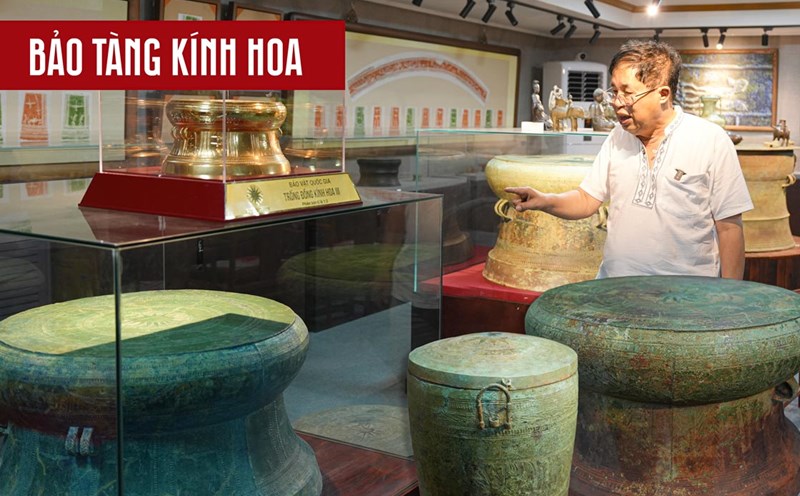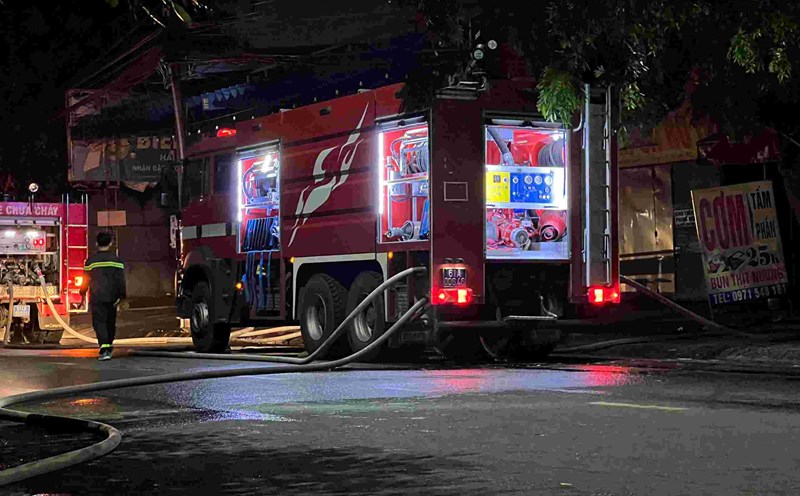National treasures - declared values and national soul
According to the Law on Cultural Heritage 2024 (Law No. 45/2024/QH15 dated November 23, 2024), expected to take effect from July 1, 2025, it stipulates: Vietnamese cultural heritage is a valuable asset of the community of Vietnamese ethnic groups, a part of the human cultural heritage, playing a great role in the cause of building and defending the country of the people.
Also according to the Law on Cultural Heritage (Article 3, Clause 7), "National treasures are relics and antiques of special rare value, typical of the country in terms of history, culture and science". For an artifact to be recognized as a national treasure, it must fully meet the criteria stipulated in the Law on Cultural Heritage 2024 and the decisions to recognize national treasures of the Prime Minister.
Basic criteria include (Article 44): a) are poisonous artifacts; b) As a unique form; c) As one of the following artifacts: The artifacts of particularly rare and typical values of the country in terms of history, culture and science related to the great event of the country, the career of the national hero, celebrity and typical historical figures; is a famous artwork for the value of ideology, humanity, and aesthetic value for a trend, a style, a era; is a product invented, typical, with high practical value, has the effect of promoting social development in a certain historical period; is a natural specimen proving the stages of formation and development of Earth history, natural history; d) Invented and registered in the museum's portfolio or monument.
They are elite, unique artifacts, representing a historical period, a culture, a pinnacle of scientific or artistic achievements of the nation, officially recognized by the State through a strict appraisal process of the National Cultural Heritage Council and a decision of the Prime Minister.
Therefore, it can be said that national treasures are considered the tangible cultural heritages with the highest value. They are not only meaningful to the country but can also be of international stature, contributing to the treasure trove of human cultural heritage. The protection and promotion of the value of national treasures is to protect the soul and national identity.
In particular, Article 42 of the Law emphasized: "The national treasure is protected and preserved by the State according to special regime. The State reserves the appropriate budget for the preservation, repair and restoration of national treasures". The implementation decrees have concretized the criteria for recognition, dossiers, procedures and special storage regimes, including the preparation of scientific records, developing the preservation plan, applying advanced techniques and ensuring absolute security, which is an important legal foundation for the preservation of these valuable heritage.
The current status of conservation
Despite the legal framework and continuous efforts, the work of protecting, preserving and storing national treasures in Vietnam still faces many challenges.
One of the most serious problems is the damage and serious damage to treasures. The Nguyen Dynasty's throne was an event that shocked public opinion and exposed weaknesses in security and supervision at important relic sites.
More alarmingly, there are cases where national treasures are damaged more than 30% just because of the wrong cleaning method with dishwashing water. The masterpiece "Trung Nam Bac Spring Garden" by famous artist Nguyen Gia Tri also suffered losses during the management process.
Incidents such as stone turtles in the Temple of Literature - Quoc Tu Giam being painted with a spear, or the tomb of King Le Tuc Tong (Thanh Hoa) being thefted from ancient artifacts all show the urgency of the problem. The work "Gat in Viet Bac" by artist Phan Ke An was also oxidized and many cracks appeared, proving its deterioration due to poor preservation conditions.
A noteworthy fact is that while the number of recognized treasures is increasing, the actual protection and conservation capacity has not yet met the requirements. This poses a big challenge for the conservation system, which is under great pressure on funding and human resources.
The Ministry of Culture, Sports and Tourism has issued strong instructions on assigning responsibility to units and individuals when incidents occur. But there should be stronger mechanisms for monitoring, checking and handling responsibilities to ensure that all levels, all specialties, and all related individuals are aware and fully fulfill their responsibilities in protecting the country's valuable assets.
The 2024 Cultural Heritage Law is expected to address existing issues and introduce new, stricter regulations. The new law will have clearer regulations on not trading in national treasures, detailing protection and preservation regimes, storage standards and forms of display (including in the electronic environment), along with ensuring responsibility for State management.
Synchronous solutions and breakthrough policies
A solid foundation from the legal system is a prerequisite. First of all, it is necessary to urgently develop and promulgate Decrees and Circulars detailing new provisions in the Law on Cultural Heritage 2024, especially clarifying the content of the "special protection and conservation regime" for national treasures. Regulations on storage standards, scientific recovery processes and display forms need to be specified, ensuring feasibility and effectiveness in the implementation process.
People are the decisive factor, therefore, there needs to be an overall strategy to build a team of cadres with sufficient expertise and vision to meet the requirements. Regular training programs at universities (such as the University of Culture, University of Fine Arts, etc.) and short-term, in-depth training courses need to be redesigned, updated with new knowledge of conservation science, restoration techniques for each type of treasure material, as well as modern museum management skills, digital technology and data analysis. Cooperating with prestigious research institutes and universities at home and abroad to exchange experts and receive advanced training programs is very necessary, as the experience of sending students to study in Japan, Australia, France, Italy... has been implemented.
Digitizing national treasures is an inevitable trend and brings many benefits. It is necessary to develop a synchronous program and have a specific roadmap to digitize all national treasures in 3D. This digital data not only serves the work of long-term archiving, scientific research (detailed analysis of structures, patterns), supporting recovery when necessary but also opens up virtual exhibition forms, helping the public easily access museums from a distance.
virtual reality (VR), augmented reality (AR) and artificial intelligence (AI) technology can be applied to vividly recreate treasures in their historical context, creating rich and attractive interactive experiences for viewers, as the Military History Museum has attracted many visitors.
Research and application of advanced materials, preservation, restoration and restoration methods need to be promoted. This requires investment in scientific research to clearly understand the nature of the original materials of each artifact, while researching, testing and applying new materials, chemicals, preservation, restoration and restoration techniques, ensuring safety, effectiveness, reversable criteria and suitability to specific climate and environmental conditions of Vietnam.
Security and risk prevention must be given top priority. It is necessary to equip a multi-layered security system, integrating many technological solutions such as smart surveillance cameras capable of analyzing behavior (detecting unusual behavior), motion sensors, vibration sensors, access sensors (especially important for open-air exhibits) and an anti-theft alarm system directly connected to the on-site security force and the nearest police agency. It is necessary to develop detailed plans for fire prevention, control and other potential risks (power outage, water leakage), with specific response scenarios for each treasure and each situation.
The synchronous implementation of solutions from institutional improvement, improving management capacity, investing in people and technology, ensuring sustainable finance, promoting the role of the community, along with selectively learning international experience, will be the key for Vietnam to successfully protect these invaluable heritages for generations to come.
Opinions from experts and managers
Mr. Nguyen Van Kinh - Director of the Kinh Hoa Museum:
The process of storing and preserving national treasures of the State is very strict. We keep the environment, humidity, and temperature standard to keep the treasures from wearing down over time. I also have a security and close monitoring system 24/24.
National treasures owned by the State will be supported with conservation funds. Private owners will have limited resources. In return, private owners can find antiques and valuable treasures that the State cannot buy by regular valuation.
Ms. Nguyen Hong Chi - Deputy Director of Thang Long Heritage Conservation Center, Hanoi
Currently, 100% of the national treasures in our exhibition area are placed in glass cabinets, meaning visitors will not have the conditions to impact the artifacts. We also have soft or hard fences to keep the distance, avoiding visitors from approaching artifacts.
For outdoor artifacts, the Center installs sea systems, fences, and staff on duty at the exhibition areas to guide and remind visitors and security cameras to monitor regularly.
Ms. Nguyen Thi Huong Thom - Head of the Conservation Department of the National Museum of History
The lack of resources in the field of artifact preservation is a difficulty not only in the National Museum of History but in most museums in Vietnam.
Currently, the Museum has a team of 10 dedicated conservation officers who are masters, engineers, and bachelors trained in Chemistry, Museumology, Culture, and Fine Arts. To meet the increasing demand for artifact preservation, the Museum still needs to supplement high-quality, well-trained and in-depth human resources.
Prof. Dr. Trinh Sinh - Vietnam Academy of Social Sciences
First of all, the heritages that have been ranked as national treasures are not only the valuable capital of individuals, agencies or the museum system, but also the valuable capital of the entire nation, a heritage that has only been acquired for thousands of years.
Therefore, it is necessary to carefully protect national treasures. It is necessary to quickly digitize artifacts, heritages, and national treasures to be able to best preserve them. Disseminate to the community as soon as possible about the value of national treasures, the purpose of which is to educate national traditions, contributing to the protection of treasures.
Prof. Dr. Truong Quoc Binh - Vietnam Institute of Culture, Arts, Sports and Tourism
National treasures need to be protected and preserved under special regimes. The storage regime must ensure full conditions such as technical equipment and technology to control the storage environment and human resources. It was not possible to wait until the incident occurred for the sewers to be handled. Second, it is necessary to put the law into practice. The law must be clear, specific, with detailed instructions, and sanctions.












